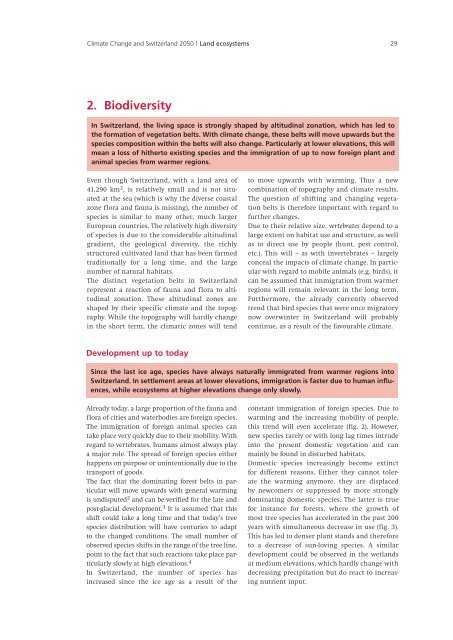Climate Change and Switzerland 2050 - OcCC - SCNAT
Climate Change and Switzerland 2050 - OcCC - SCNAT
Climate Change and Switzerland 2050 - OcCC - SCNAT
You also want an ePaper? Increase the reach of your titles
YUMPU automatically turns print PDFs into web optimized ePapers that Google loves.
<strong>Climate</strong> <strong>Change</strong> <strong>and</strong> Switzerl<strong>and</strong> <strong>2050</strong> | L<strong>and</strong> ecosystems 29<br />
2. Biodiversity<br />
In Switzerl<strong>and</strong>, the living space is strongly shaped by altitudinal zonation, which has led to<br />
the formation of vegetation belts. With climate change, these belts will move upwards but the<br />
species composition within the belts will also change. Particularly at lower elevations, this will<br />
mean a loss of hitherto existing species <strong>and</strong> the immigration of up to now foreign plant <strong>and</strong><br />
animal species from warmer regions.<br />
Even though Switzerl<strong>and</strong>, with a l<strong>and</strong> area of<br />
41,290 km 2 , is relatively small <strong>and</strong> is not situated<br />
at the sea (which is why the diverse coastal<br />
zone flora <strong>and</strong> fauna is missing), the number of<br />
species is similar to many other, much larger<br />
European countries. The relatively high diversity<br />
of species is due to the considerable altitudinal<br />
gradient, the geological diversity, the richly<br />
structured cultivated l<strong>and</strong> that has been farmed<br />
traditionally for a long time, <strong>and</strong> the large<br />
number of natural habitats.<br />
The distinct vegetation belts in Switzerl<strong>and</strong><br />
represent a reaction of fauna <strong>and</strong> flora to altitudinal<br />
zonation. These altitudinal zones are<br />
shaped by their specific climate <strong>and</strong> the topography.<br />
While the topography will hardly change<br />
in the short term, the climatic zones will tend<br />
Development up to today<br />
Already today, a large proportion of the fauna <strong>and</strong><br />
flora of cities <strong>and</strong> waterbodies are foreign species.<br />
The immigration of foreign animal species can<br />
take place very quickly due to their mobility. With<br />
regard to vertebrates, humans almost always play<br />
a major role. The spread of foreign species either<br />
happens on purpose or unintentionally due to the<br />
transport of goods.<br />
The fact that the dominating forest belts in particular<br />
will move upwards with general warming<br />
is undisputed 2 <strong>and</strong> can be verified for the late <strong>and</strong><br />
post-glacial development. 3 It is assumed that this<br />
shift could take a long time <strong>and</strong> that today’s tree<br />
species distribution will have centuries to adapt<br />
to the changed conditions. The small number of<br />
observed species shifts in the range of the tree line,<br />
point to the fact that such reactions take place particularly<br />
slowly at high elevations. 4<br />
In Switzerl<strong>and</strong>, the number of species has<br />
increased since the ice age as a result of the<br />
to move upwards with warming. Thus a new<br />
combination of topography <strong>and</strong> climate results.<br />
The question of shifting <strong>and</strong> changing vegetation<br />
belts is therefore important with regard to<br />
further changes.<br />
Due to their relative size, vertebrates depend to a<br />
large extent on habitat use <strong>and</strong> structure, as well<br />
as to direct use by people (hunt, pest control,<br />
etc.). This will – as with invertebrates – largely<br />
conceal the impacts of climate change. In particular<br />
with regard to mobile animals (e.g. birds), it<br />
can be assumed that immigration from warmer<br />
regions will remain relevant in the long term.<br />
Furthermore, the already currently observed<br />
trend that bird species that were once migratory<br />
now overwinter in Switzerl<strong>and</strong> will probably<br />
continue, as a result of the favourable climate.<br />
Since the last ice age, species have always naturally immigrated from warmer regions into<br />
Switzerl<strong>and</strong>. In settlement areas at lower elevations, immigration is faster due to human influences,<br />
while ecosystems at higher elevations change only slowly.<br />
constant immigration of foreign species. Due to<br />
warming <strong>and</strong> the increasing mobility of people,<br />
this trend will even accelerate (fig. 2). However,<br />
new species rarely or with long lag times intrude<br />
into the present domestic vegetation <strong>and</strong> can<br />
mainly be found in disturbed habitats.<br />
Domestic species increasingly become extinct<br />
for different reasons. Either they cannot tolerate<br />
the warming anymore, they are displaced<br />
by newcomers or suppressed by more strongly<br />
dominating domestic species. The latter is true<br />
for instance for forests, where the growth of<br />
most tree species has accelerated in the past 200<br />
years with simultaneous decrease in use (fig. 3).<br />
This has led to denser plant st<strong>and</strong>s <strong>and</strong> therefore<br />
to a decrease of sun-loving species. A similar<br />
development could be observed in the wetl<strong>and</strong>s<br />
at medium elevations, which hardly change with<br />
decreasing precipitation but do react to increasing<br />
nutrient input.

















